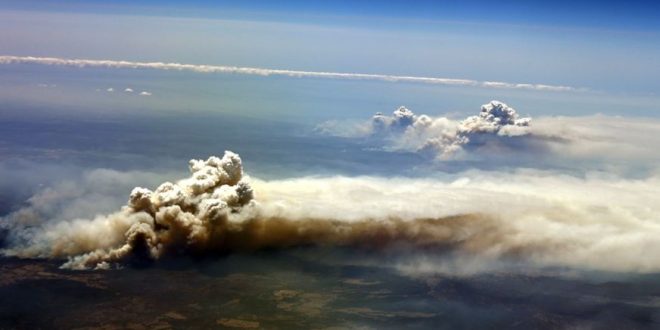21 December, 2019
By SJA Jafri + BBC
 CANBERRA/ SYDNEY/ MELBOURNE: Australia is grappling with massive bushfires fuelled by record-breaking temperatures and months of severe drought.
CANBERRA/ SYDNEY/ MELBOURNE: Australia is grappling with massive bushfires fuelled by record-breaking temperatures and months of severe drought.
Fires in New South Wales (NSW) have burned at least 2.7m hectares (7.4m acres) this season, destroying more than 700 houses. Eight people – including two volunteer firefighters whose vehicle was hit by a tree – have died.
Hot, dry weather combined with prolonged drought and strong winds have created perfect conditions for fire to spread rapidly.
Nearly 100 fires are burning across the state, with many uncontained and continuing to threaten lives.
The fires have been exacerbated by 40C temperatures and strong winds in recent days, creating difficult conditions for the 2,500 firefighters deployed in the field. Large fires are burning in the north region between Port Macquarie and Byron Bay.
 Further south there are fears that the vast Gosper’s Mountain fire, which originated in the Wollemi National Park, may merge with the Green Wattle Creek blaze in the lower Blue Mountains.
Further south there are fears that the vast Gosper’s Mountain fire, which originated in the Wollemi National Park, may merge with the Green Wattle Creek blaze in the lower Blue Mountains.
Smoke from these fires has periodically blown south-eastwards to reach Sydney, causing severe air pollution in Australia’s largest city.
To put the fire damage in New South Wales in perspective, 1.8 million hectares burned in the 2018 California wildfires and some 900,000 hectares were lost in the 2019 Amazon fires.
Flames up to 70m (230ft) in height have been reported.
Many Australians are asking that very question and whether these fires are linked to climate change – but the science is complicated.
 Scientists have long warned that a hotter, drier climate will contribute to fires becoming more frequent and more intense.
Scientists have long warned that a hotter, drier climate will contribute to fires becoming more frequent and more intense.
Australia’s deadliest bushfire disaster was “Black Saturday” in February 2009, when some 180 people died in Victoria.
Data shows that Australia has warmed overall by slightly more than 1C since 1910, with most of the heating occurring since 1950, the Bureau of Meteorology says.
Australia broke its all-time temperature record twice this week. Tuesday’s average maximum of 40.9C was broken a day later by Wednesday’s 41.9C, both beating a 2013 record of 40.3C.
The main climate driver behind the heat has been a positive Indian Ocean Dipole (IOD) – an event where sea surface temperatures are warmer in the western half of the ocean, cooler in the east.
The difference between the two temperatures is currently the strongest in 60 years.
 Pressmediaofindia
Pressmediaofindia




